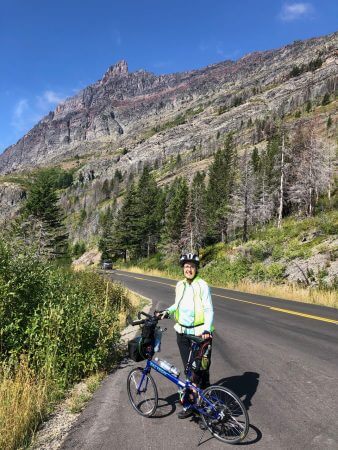Ruthy Kanagy shares her breathtaking ride in Glacier this summer
I recently spent a week at Glacier National Park in Montana, USA, with a hiking club from Eugene, Oregon. After several days hiking with the group to beautiful glacial lakes, I decided it was time to ride. I’d brought along my trusty, lightweight Pocket Rocket Pro (recently converted to E-assist), for the purpose of riding the spectacular Going-to-the-Sun Road. I’d heard about this iconic route, carved out of rock in 1933, as one of the most thrilling rides in the U.S.. Would I be up to the challenge? With my e-assist, I felt confident that I could reach the top.
September 5, 2019, dawned cloudy and chilly. I waited till the mist lifted and the sun peaked out. As I started from the east entrance to Glacier National Park (at St. Mary), there were few cars and no other cyclists. The busy Labor Day weekend had passed. I’d forgotten to bring my senior “Golden Eagle” pass allowing lifetime admission to National Parks, but I was happy to pay $20 for the Annual Senior Parks Pass to support our national parks.



In front of the massive Going-to-the-Sun Peak in Glacier National Park, Montana.





I kept my e-assist at level 2 or 3 for the climb and still had 50% of battery left (using 3 LiGo batteries). I took about 2.45 hours going up (stopping often for photos) and just 57 minutes back to the camp at St. Mary. It can be a bit intimidating zooming down the narrow road, with a sheer drop off to your right. I concentrated on keeping my hands and arms loose on the handlebars and taking the lane! On most of the route, the posted speed limit is 25 or 35, so I wasn’t holding up car traffic on the descent.

Between June and Labor Day there are restrictions on cycling the narrow, winding Going-to-the-Sun Road — bikes are prohibited in both directions from 11 am to 4 pm. Since it was after Labor Day when I rode, there were no restrictions. I met two cyclists at the top who had ridden up the west side, which is a bit longer. One was sitting in a wheelchair and explained that he had ridden up on a handcycle. Bravo! For more information see http://www.
My Pocket Rocket Pro e-assist performed beautifully and riding in Glacier National Park is an experience I will never forget!
~ “Ruthy Kanagy leads bicycle tours to Japan — See japancycletours.com. The next tour is July 2020 to the island of Hokkaido” ~
(photos credit to Ruthy Kanagy)

